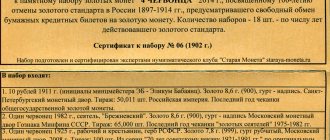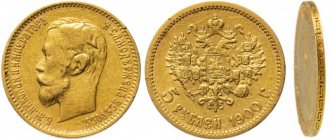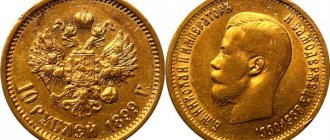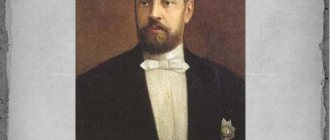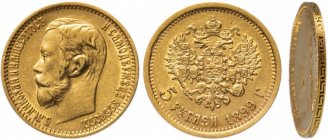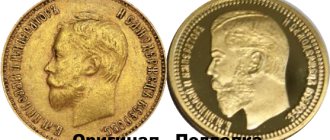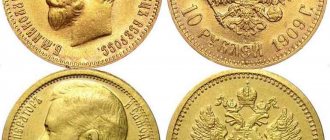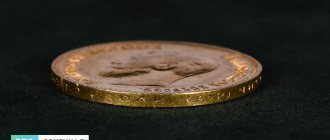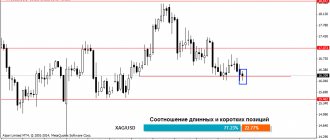The issue of large denomination gold coins was of particular importance for the sovereigns of Russia. From the 15th to the 17th centuries. these coins more often became rewards than means of payment. Or they were still used for payments, but only for international ones. Only since the 18th century. There is a need for such money in the country’s domestic market.
A coin made of “royal metal” emphasized the strength and independence of royal power, the sustainability of economic growth and encouraged foreign merchants to cooperate.
Russian gold coins: the beginning
“Chervonets” have long been the name for foreign and Russian large denomination coins containing high-grade gold.
Stable production of such copies in Russia began under Emperor Ivan III (second half of the 15th century). At the same time, the first gold coin of Russian coinage - the “zlatnik” of the Kyiv prince Vladimir - was issued five centuries earlier.
Its official name is unknown. The minting of zlatnik was important from a political point of view: during this period, Kyiv asserted its importance and established new relations with neighboring states. Under Prince Vladimir, the country did not have its own gold; instead of Russian coins, they paid with Byzantine or Arab ones.
The solidus of the Byzantine emperor, a rival whom the Kiev prince looked up to, was taken as a model for coinage. Both coins are similar in weight, gold purity and images on the obverse and reverse.
11 known examples of this issue were found in treasures discovered in the 19th century. Ten of them are in museum collections; it is unknown who owns the eleventh. Modern collectors can purchase a zlatnik in the form of a commemorative gold copy, issued in honor of the millennium of ancient Russian coinage (denomination 100 rubles, edition 1988).
Proof of status
Issues of small circulations of gold coins under Ivan III are explained by almost the same reasons as under Prince Vladimir. The Emperor unites the Russian lands, destroys the Tatar-Mongol yoke, and streamlines the laws. The Byzantine double-headed eagle had already become Moscow's; the Grand Duke had a different goal during this period: to prove the equality of Russia and its European neighbors.
During this period, English and Hungarian coins (“shipman” and “Ugric” gold) were used as models for minting. In addition to these foreign gold coins, Venetian and Dutch ducats circulated in Muscovite Rus'. The word “Ugric” was used to describe both Russian and foreign coins: this definition indicated the purity of the metal. The state still had not established industrial gold mining, so new Russian editions were minted from melted down foreign ones.
It is possible that Moscow gold was sometimes used to pay, for example, specialists invited from abroad. However, they were usually intended for rewards and gifts. A hole or ear was made on such a granted coin to be worn around the neck or hung on an icon. You can now see these gold ones in the museum.
Until the end of the 17th century, the rulers of Russia, following Ivan III, minted gold coins with their portrait and a double-headed eagle.
Soviet period
Perhaps the most famous chervonets coin belongs to this period. After the civil war, the country's financial situation was unenviable. Therefore, it was decided to carry out a reform. The changes invented by Witte were taken as a model. It was planned to resume circulation of hard money in the country. The question arose about the designation. Ideology did not allow the use of the official royal name “imperial”. Everything was moving towards being called “federal”. But then they remembered about the chervonets. We decided that we could limit ourselves to this. And the gold content was similar to the 10-ruble coin from the time of Nicholas II. Until the year 25, the coin was quite actively used on the exchanges of Harbin, Rome, Berlin, and London.
Origin of the name "chervonets"
The word “chervonets” was formed from the phrase “chervonets gold”: an alloy of copper and gold was used for minting. The result of combining metals corresponded to samples from 916 to 986. Even a small amount of copper in the alloy gives a reddish tint, so the color of such gold was designated by the word “red” (after the method of extracting red dye from the cochineal mealybug).
The official name “chervonets” during Soviet times was used for a new monetary unit, equal in gold content to a ten-ruble coin with a portrait of Nicholas II. Therefore, in recent decades, this word has often been used to refer to coins and banknotes in denominations of 10 rubles or anything in the amount of ten.
On chervonets issued before the 18th century, the denomination was not indicated: when calculated, they corresponded to silver rubles (from 1 ruble 20 kopecks to 3 rubles 50 kopecks in different periods).
Implementation
It is necessary to understand that not only coins were minted, but banknotes were also issued. Their gold content was indicated on the tickets. At the same time, the exchange for precious metal was carried out freely. More than two million coins were minted in 1923 (and presumably 1924). Also in 1925 there was another 600,000 circulation, but most of it was melted down. From 1975 to 1982, the same coins were additionally reissued. Their number ranges from 6.6 to 7.4 million units. Coins issued during the Soviet Union are also known as “Sower”, due to the image of a peasant planting seeds. The second large-scale release was timed to coincide with the 1980 Olympics. Now they are considered, as a rule, from the position that these are investment coins. Separately, it is worth mentioning one hundred thousand chervonets, which were created for collectors and are of improved quality.
Chervontsi of the 17th century
After the Time of Troubles, the Romanov dynasty came to power in 1613. Before the monetary reform of Peter I, rulers minted award coins of a whole chervonets, part of it, or several chervonets.
From 1613 to 1682, both sides of such specimens were decorated with double-headed eagles; under Princess Sophia, there were portraits of Tsars John, Peter and their sister-regent. The traditional name “Ugric” was assigned to these coins (this is how they are called in modern numismatics).
The year of minting began to be indicated under Peter I (first in letters of the alphabet, then in Arabic numerals).
The connection of historical times is clearly visible on the double “Ugric” of Alexei Mikhailovich: the images on its sides in general repeat the golden prince Vladimir or the Byzantine solidus. Perhaps the appearance of such a chervonets is connected with the tsar’s plans to become the sole trustee of the universal Orthodox Church. One of two known copies of the coin is kept in the Hermitage.
Story
The gold ten of 1901 issue appeared thanks to the monetary reforms of Yu. Witte. In order to improve the economic situation of the state, the Minister of Finance introduced the backing of the ruble in gold.
Without detracting from the dignity of the coin, it should still be said that this is just a two-centimeter gold circle. In pre-revolutionary Russia, it was a common banknote for payments between buyers. It was freely exchanged for paper money and vice versa. Historians claim that the Russians were not very fond of them because of their small size and the inconvenience associated with them. Ask yourself which is easier to lose: a small gold round or a large paper bill, and the answer will become obvious.
But hiding treasures with “royal chervonets” was very convenient. This is probably the reason for the numerous stories and legends about treasures, inherited wealth and criminal crimes associated with this coin.
The gold tenth originally weighed 12.9 grams and was pegged to silver. With the appearance in circulation of the gold chervonets of Nicholas II of 1901, 10 rubles were equated to pure gold weighing 7.8 grams (rounded).
Chervontsi of Peter I
The transformations of Peter the Great required the renewal of a dilapidated economic system, the crisis of which in the middle of the 17th century had already led to several popular unrest.
In 1701, coins of one and two chervonets were issued, modeled after the Dutch ducats. Unlike previous issues, Peter I's chervonets were intended not only for the purchase of goods abroad, but also for payments within the country. Gold sand for minting was purchased in China. At the same time, active development of precious metal deposits in Russia begins.
The chervonets of 1701 was made from 969 standard metal. It contained 3.36 g of gold and weighed 3.47 g (double chervonets - 6.94 g). It was distinguished from the ducat by Russian inscriptions (however, on the copy of 1716, intended for the Tsar’s trip to Europe, inscriptions were minted in Latin).
Chervonets, issued from 1701 to 1718, were distinguished by many small details, however, the main images were repeated: on the obverse - a portrait of the sovereign with a laurel wreath on his head (a symbol of triumph, the immortality of power), on the reverse - a double-headed eagle. The cost of these coins, which did not have a specified denomination, was determined by gold prices and did not exceed 2 rubles. 30 kopecks silver
Chervonets with a portrait of Peter I were in circulation before the reform of Anna Ioannovna.
Chervonets 1706
This coin is interesting because the year of minting on its reverse is indicated in letters of the Old Russian alphabet. The exact number of surviving copies has not been established.
Two-ruble chervonets
The need to replenish the treasury led to changes in the rules for minting chervonets. From 1718 to 1728, coins with the indicated denomination of 2 rubles were issued in Russia. For their production, gold of a lower standard was used than in chervonets of previous years (781 samples). It was obtained from melted down foreign coins. This gold coin received the name “Andreevsky” because of the design depicting the Apostle Andrew on the reverse instead of a coat of arms. It weighed 4.1 g - more than a chervonets without a denomination.
Two-ruble chervonets with a portrait of the ruling person were minted until the reign of Peter II, when they were recognized as unprofitable and inconvenient. Mints have again begun producing gold coins without a specified denomination.
Due to the peculiarities of minting, two-ruble chervonets of the same edition often differ from each other.
“Andreevskie Novodelnye” and more
It is interesting that the minting of two-ruble chervonets or coins with portraits of late rulers did not stop completely - a modern collector can get into the hands of even a copy from 1890. The remakes were made according to private orders; they participated in exhibitions organized by the government. Such releases were prohibited by decree of Alexander III.
An examination conducted by a specialist will help to distinguish a real chervonets, for example, 1718-1728, from its later counterparts.
Where can you buy or sell
Leadership in matters of trading rare royal chervonets at auction houses. By organizing online bidding, the auction attracts many potential interested parties without territorial reference.
In addition, auction houses guarantee the reliability of the transaction to the seller and the authenticity of the goods to the buyer when they take on the functions of an intermediary. This is especially true for beginners and investors who hardly know what real gold from the 17th–19th centuries looks like and what differences there are between fake chervonets.
There are a great many similar auction houses and galleries. Among domestic traders, the following are famous: Alexander, Tsar's coins, Volmar, Russian Heritage. From foreign auctions: Künker, Numismatica Genevensis, Gorny & Mosch, Stack's Bowers & Ponterio.
Prices for royal gold chervonets today
To complete the picture, I am posting here a table with current prices for royal gold coins. The report on how much banknotes are worth is compiled based on transactions carried out over the past few years.
| Year of minting of the chervonets | G | VG | F | VF | XF | AU | UNC | Proof |
| 1797 SM-GL | — | — | — | 507 509 | 262 657 | 1.01 million | — | — |
| 1796 BM | — | — | — | 3.40 million | 2.00 million | — | — | — |
| 1796 SPB without initials | — | — | — | 396 777 | 525 000 | 896 589 | — | — |
| 1796 SPB-TI | — | — | — | — | 579 469 | — | — | — |
| 1796 SPB-TI remake | — | — | — | — | — | — | 2.50 million | — |
| 1766 SPB-TI | — | — | — | — | 1.37 million | — | — | — |
| 1763 St. Petersburg | — | — | — | 367 432 | 625 000 | — | — | — |
| 1762 St. Petersburg | — | — | — | 3.58 million | — | — | — | — |
| 1757 SPB-Y | — | — | — | 553 183 | 870 115 | — | — | — |
| 1753 | — | — | — | — | 1.39 million | 1.86 million | — | — |
| 1751 | — | — | — | 1.52 million | 2.02 million | 1.09 million | — | — |
| 1749 | — | — | — | — | — | 977 041 | — | — |
| 1748 | — | — | — | 676 667 | 1.65 million | 1.20 million | — | — |
| 1747 | — | — | — | 5.99 million | — | — | — | — |
| 1746 | — | — | — | 7.65 million | — | — | — | — |
| 1744 | — | — | — | 759 704 | 1.04 million | 2.00 million | — | — |
| 1739 | — | — | — | 1.30 million | — | — | — | — |
| 1738 remake | — | — | — | — | 700 000 | — | 287 303 | — |
| 1729 with bow | — | — | — | — | 5.28 million | 4.26 million | — | — |
| 1729 without bow | — | — | — | — | — | 6.81 million | — | — |
| 1716 | — | — | — | — | 2.65 million | 3.90 million | — | — |
| 1714 | — | — | 1.00 million | — | — | — | — | — |
| 1714 3 | — | — | — | 918 509 | — | 1.39 million | — | — |
| 1713 DL | — | — | — | — | — | 3.50 million | — | — |
| 1712DL | — | — | — | 2.08 million | 6.10 million | — | 2.80 million | — |
| 1712 DLG large | — | — | — | — | 9.00 million | — | — | — |
| 1712 DLG average | — | — | — | 1.28 million | 3.60 million | — | — | — |
| 1711 | — | — | — | 2.62 million | — | — | — | — |
| 1701 | — | — | — | 4.15 million | — | — | — | — |
Dutch Russian ducats
Under Anna Ioannovna, a secret semi-legal minting of chervonets, identical to Dutch ducats, was founded in Russia. The production of these coins, nicknamed "lobanchiki" or "arapchiki", continued until the official protest of the Netherlands in 1869.
The economy of the Russian Empire required easily recognizable coins that would inspire confidence abroad. Ducats, whose appearance had not changed for many centuries, were perfect for this role. The manufactured counterfeits played a major role in Russia's international trade and facilitated the supply of military campaigns outside the country.
Tips for a novice collector
If you decide to invest your money in coins, it is worth remembering some of the nuances of this business:
- You can buy rare coins at specialized auctions, live or online,
- Many stores offer to buy Nikolaev chervonets in excellent condition. For example, the online store Slitok.Gold sells coins of that era with a guarantee of authenticity and good preservation.
- The authenticity of the Nikolaev chervonets must be verified by an experienced expert
- A change in the price of gold entails a change in the price of gold coins. Gold is a constant metal in terms of price, but there are still fluctuations, and it’s realistic to choose the best moment to buy coins or sell them.
- The value of coins is also influenced by the dollar exchange rate, which also needs to be monitored.
Regular and double: golden chervonets of Peter's daughter
During the reign of Elizabeth, ordinary chervonets were mostly minted, but in 1749 double circulations were issued. Under the empress, other large denomination gold coins appeared:
- 2 rubles;
- 5 rubles (“half-imperial”);
- 10 rubles (“imperial”).
The imperial and semi-imperial were intended for use within the country, and the chervonets (regular and double) were for foreign trade.
It is worth noting that the image of the Apostle Andrew briefly returned to the chervonets in 1749 (in addition to the regular and double chervonets, the same “Andreev’s” ones were minted in these years).
Degree of preservation
The question of how much the Nikolaev chervonets costs cannot be answered without mentioning the generally accepted gradations of preservation. A gold coin of the same denomination may cost $10,000, or it may cost 10 times more. Its price both at the world's leading auctions and in a numismatist's shop will be determined by how well it is preserved.
The global gradation of safety of rare and collectible coins is as follows:
- UNC. This is how the most intact, and therefore the most expensive, chervonets are designated. They have no visible damage or abrasions, and the design is clearly engraved. They may have been cleaned and polished by the previous owner, but patinated examples are more expensive.
- AU. These examples have barely noticeable wear (mostly the protruding parts have been smoothed out), but are still shiny.
- XF. The wear is visible to the naked eye. Small relief elements are already difficult to distinguish. There is no shine.
- VF. Minor potholes and notches are acceptable, protruding parts are smoothed. Overall safety must exceed 75%.
- VG. The copy looks worn. About half of the original coinage is visible to the naked eye.
Chervontsi on the eve of the revolution
After Paul I, only counterfeit Dutch ducats continued to be issued in Russia from coins that were called “chervonets” and had no denomination.
Under Nicholas I, to reduce platinum reserves in the treasury, platinum chervonets were minted for some time. Gold coins began to play an important role in the country’s domestic market only towards the end of the 19th century.
Fifteen turned into ten
During the 19th century. The Russian economy failed to overcome the discrepancy in the value of paper and metal money. By the end of the century it was necessary to reform the monetary system.
After the reform of Minister S.Yu. Witte's main monetary unit could have been bimetallic coins. However, their stability was questioned, and the new specimens, released in 1895-97, were made of 900 gold.
The new coins received the old name - imperial and semi-imperial, but their denomination was increased to 15 and 7.5 rubles. The Nicholas Imperial corresponded to the ten-ruble imperial of Alexander III. On the obverse of the chervonets there was a portrait of the sovereign.
The circulations were large (sometimes issues were even ordered abroad), so the value of many Nikolaev chervonets is now estimated only by the precious metal content in them.
The last issue of chervonets under Nicholas II dates back to 1911. However, a century later, there are hundreds of times more coins from this year of issue than indicated in official documents. Probably, during the revolution and after it, chervonets were minted underground.
Coin Rus
Trial copies of the new monetary unit “Rus” were issued in 1895. The denomination of the coin was ⅓, ⅔ and one imperial. However, the new name was never used, and proof copies are now owned by museums and private collections.
Russian 100 francs
The collector's coin was issued in 1902 (900 gold, mintage 235-236 copies). On its reverse there are both Russian (37.50 rubles) and French (100 francs) denominations. Perhaps this circulation was going to be used to strengthen diplomatic relations with France. All copies released in 1902 were presented to the Tsar's relatives.
Coronation Jubilee 1906
Chervonets of Nicholas II, issued in an edition of 10 copies in 1906, is one of the most expensive Russian coins. This was probably a test mint in preparation for the coronation anniversary.
The cost of coins depends on their authenticity, age, condition, size and characteristics of the circulation, and the number of surviving copies. “Royal Metal” lives up to its name: some chervonets are so rare that they can only be seen in a museum. Such coins stand out from the rest due to their quality and release features and, despite their high cost, attract the attention of most collectors.
How to spot a fake
10 rubles of 1901 made of gold due to its price and popularity attracts many counterfeiters. Cases of counterfeiting are quite common in this environment, which makes it urgent to correctly distinguish the original from all kinds of fakes.
The low price for a sold sample should be the first thing to worry about. The owner of a real coin will never give it away for nothing. Here the conclusion is clear: fake or criminal (stolen).
A high price is also not a guarantee of authenticity. They may deliberately inflate the price in order to reduce vigilance, and then make a concession during the bargaining process and sell the buyer a fake.
When purchasing a coin, you should be careful and check in every possible way. It should be noted that there are no universal ways to distinguish a fake from an original.
You can give only a few tips for independently analyzing the chervonets, but it is better to contact experienced numismatists:
- know the historical period of coin issue. For example, the image of an eagle must correspond to that year's national emblem;
- check "to the teeth". Determine the degree of metal hardness. Gold is a soft metal and can easily leave marks. Do not forget that a fake may be made of lead;
- magnetic properties. Gold has no magnetic properties;
- foreign metal. It is possible that the coin is gold plated. By slightly scratching the sample with a needle, it is easy to recognize a fake;
- nature of the surface. A perfectly smooth surface should raise suspicions. Having passed through decades, the chervonets cannot look perfect, especially from circulation;
- inspection of the herd. The initials of the mintzmeister must coincide with the officials who actually worked that year;
- specifications. The coin must correspond to the weight and diameter of that year of minting;
- detailed inspection of the stamp. Minting is a very labor-intensive process; counterfeits are usually cast. Such fakes will have small tubercles, drops of metal on the surface of the workpiece, easily distinguishable with a magnifying glass.
There are, of course, exemplary fakes that can mislead even experts, but such cases are very rare. If such a copy somehow ends up in the collection, do not be upset. A talented fake is also a rarity, which sometimes costs significant money.
How often are 10 rubles from 1901 counterfeited?
The 10 ruble coin, issued under the last Russian Tsar, is one of the most frequently counterfeited. Immediately after the revolution, the Bolsheviks needed money, and the country was also in debt to European states. Gold coins of the new type were not accepted abroad, so the Bolsheviks decided to use a stamp partially preserved after the revolution. With its help, a fairly large number of counterfeit royal chervonets were issued.
With the development of technology and the emergence of online stores, many Chinese counterfeits have appeared. The banknotes are made with high quality, with a high degree of reliability, but they do not contain gold. In addition, such coins are completely legal, because... are positioned by the seller as replicas in “imitation of antique style.”
In the beginning there was a resolution
It is difficult to name the exact date of the beginning of the monetary reform, carried out under the leadership of People's Commissar of Finance Grigory Sokolnikov (he officially took this position on November 22, 1922, but actually began acting as People's Commissar earlier). You can take November 27, 1922 as the starting point - the date the Soviet chervonets were put into circulation. The denomination declared by the decree of the Council of People's Commissars of the RSFSR dated November 3, 1921 can be considered the beginning. It can be considered that it all began already in mid-1921, when the Council of People's Commissars and the Central Committee of the Russian Communist Party (Bolsheviks) (RCP (b)) discussed projects for the upcoming reform, and newspapers were ordered not to report on it. The earliest possible date is March 1921, when, in the conditions of the severe political and economic crisis the country was experiencing, at the Tenth Congress of the Russian Communist Party (Bolsheviks) the policy of “war communism” was abandoned and a new economic policy, the NEP, was adopted. One of the resolutions of the congress sounded like this: “The congress instructs the Central Committee to fundamentally review our entire financial policy and tariff system and carry out the necessary reforms in Soviet order.”
No money needed
Delegates of the X Congress of the RCP (b), at which the decision was made to transition to the NEP
Photo: RGAKFD/Rosinform, Kommersant
Delegates of the X Congress of the RCP (b), at which the decision was made to transition to the NEP
Photo: RGAKFD/Rosinform, Kommersant
By the time the NEP was announced, the Russian economy was almost completely destroyed by wars, revolutions and inept decisions and actions of the authorities. Industrial production by 1920 compared to 1913 decreased seven times. Agricultural production during the same period decreased by 33–40%.
In the first post-revolutionary years, the idea of eliminating money as a means of payment and its gradual withering away during the transition to socialism was very popular among the Soviet leadership. The program of the RCP (b) written by Lenin stated: “Based on the nationalization of banks, the RCP strives to implement a number of measures that expand the scope of non-monetary payments and prepare for the destruction of money: mandatory holding of money in the people's bank; introduction of budget books, replacement of money with checks, short-term tickets for the right to receive food, etc.” People's Commissar of Finance Isidor Gukovsky, in his speech at the 1st All-Russian Congress of Economic Councils (held from May 26 to June 4, 1918), stated: “Finance is not supposed to exist in a socialist society, and therefore I apologize for both the existence of finance and for my own performance".
Cash circulation was replaced by direct product exchange - free issuance of food rations and consumer goods on cards, medicines according to doctor's prescriptions, abolition of heating fees, transport fares, utilities and postal services. Cash payments between enterprises were cancelled. In January 1920, the People's Bank of the RSFSR was liquidated - there was nowhere to store money except at home, and it was impossible to legally transfer it to someone else.
If at the end of 1917 6.2% of wages were paid in kind (in the form of food rations and enterprise products), then at the beginning of 1921 - 97.3%.
The cost of food rations received by card, translated into market prices, was 4–5 times or more higher than cash payments. The size of the salary in monetary terms has ceased to mean something for many residents of the country. The lack of material incentives led to a drop in labor productivity in both industry and agriculture.
The country was experiencing hyperinflation. According to the Market Research Institute, founded by the outstanding Russian economist Nikolai Kondratiev, the index of free prices in Moscow in January 1921 was 27 thousand times higher than the 1913 figure. Prices for food products increased by 34 thousand times, non-food products - by 22 thousand times. The price of salt increased the most - 143 thousand times.
